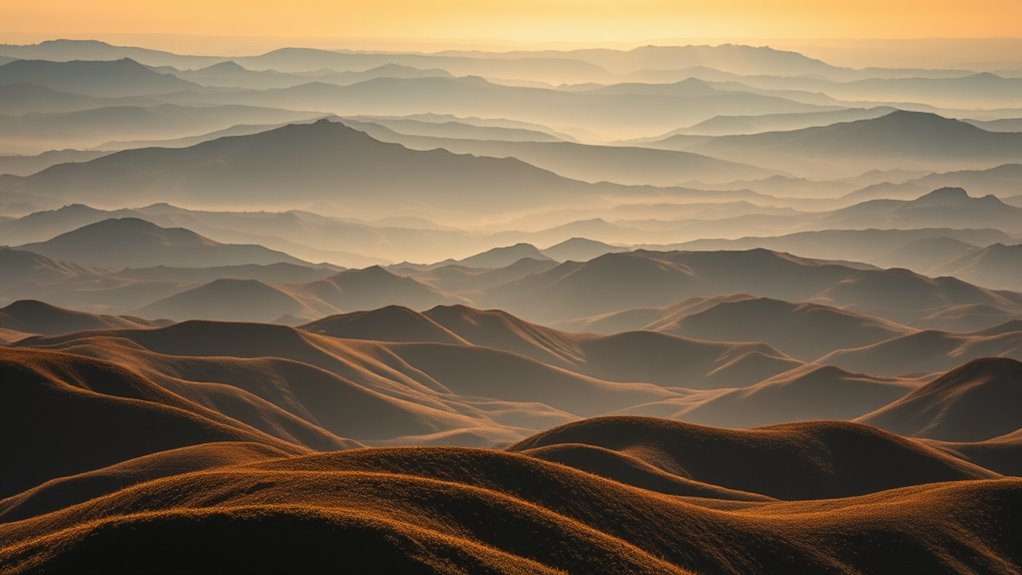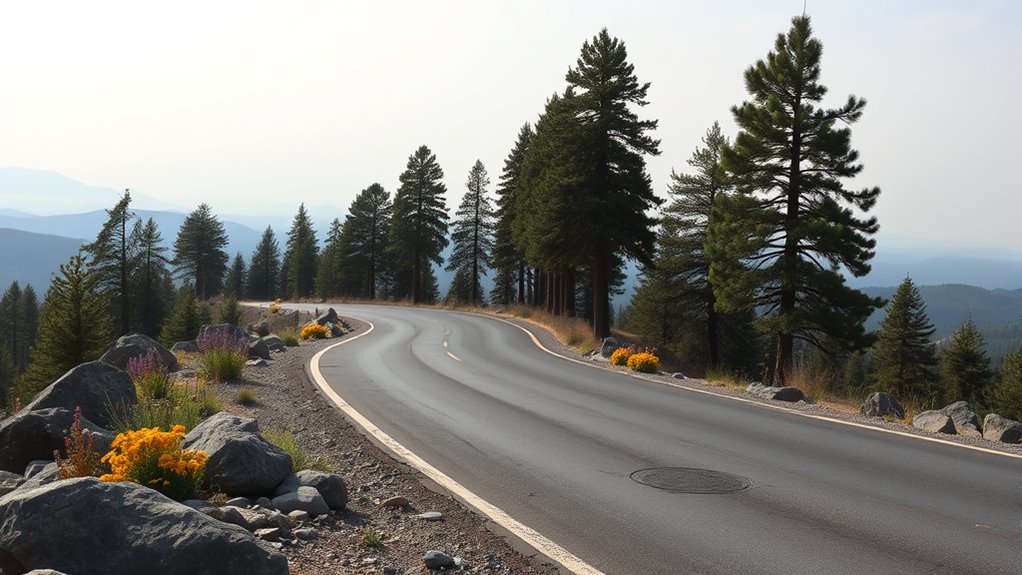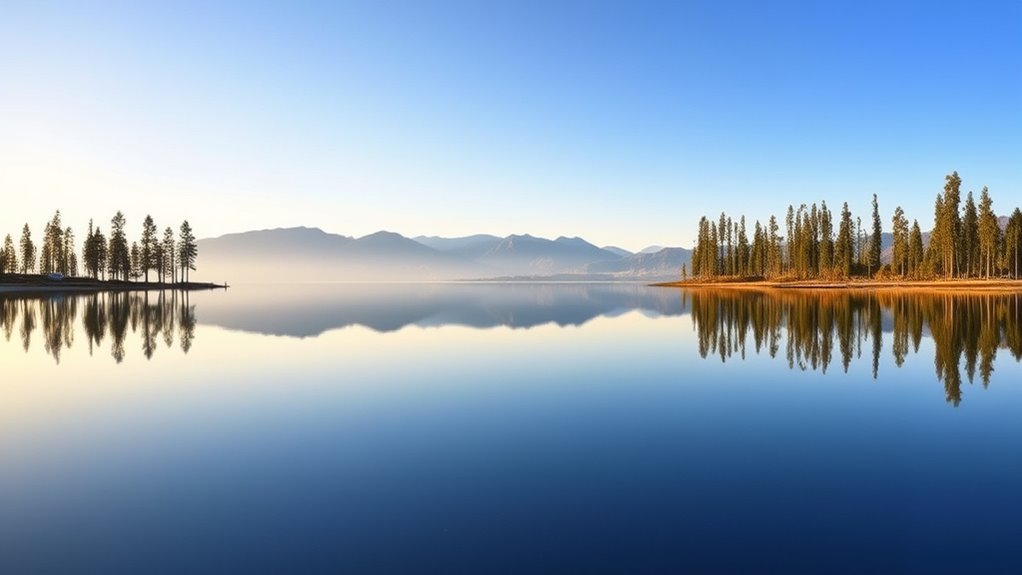To capture the infinity illusion, use a wide-angle lens and a sturdy tripod to enhance depth and stability. Seek open locations like salt flats, beaches, or cliffs with horizon lines that blend seamlessly into water or sky. Compose carefully with foreground interest, leading lines, and balanced elements. Optimize natural light during sunrise or sunset, and enhance the scene with post-processing adjustments. Keep exploring to uncover more tips for mastering this mesmerizing effect.
Key Takeaways
- Choose expansive, unobstructed locations like beaches or salt flats during sunrise or sunset for optimal infinity effects.
- Use a wide-angle lens and a sturdy tripod to capture depth and ensure sharp reflections.
- Compose with foreground elements and leading lines guiding the viewer towards the horizon for enhanced perspective.
- Manipulate light and weather conditions, favoring soft, diffused light and reflective surfaces for surreal reflections.
- Post-process by increasing contrast, sharpening horizons, and emphasizing sky colors to deepen the infinity illusion.
Understanding the Principles Behind the Infinity Effect

To understand the infinity effect, you need to grasp how reflections and perspective work together to create the illusion of endless depth. Reflections bounce light to mimic an unending space, making it seem like the scene extends beyond what’s visible. Perspective plays a pivotal role by guiding your eye toward a vanishing point, drawing you into the scene’s depth. When you position your camera strategically, you align reflective surfaces and viewpoints to enhance this sense of infinity. Light and angles are key: careful manipulation of these elements amplifies the illusion. Recognizing how reflections multiply visual layers and how perspective directs focus allows you to craft compelling images that feel boundless. Mastering these principles helps you transform simple scenes into mesmerizing, infinite landscapes. Additionally, understanding the relationships involved in visual perception can deepen your ability to create impactful compositions.
Essential Equipment and Settings for Infinite Landscapes

Achieving stunning infinite landscapes requires selecting the right equipment and settings to maximize the illusion. Use a wide-angle lens, preferably between 10-24mm, to capture expansive scenes and create depth. A sturdy tripod is essential to keep your camera stable during long exposures, which help smooth out water or clouds for a seamless look. Set your aperture between f/8 and f/16 to ensure sharpness across the scene. Use a low ISO to minimize noise, and adjust shutter speed to balance exposure—longer exposures enhance the sense of infinity. Consider using a graduated ND filter to control bright skies and maintain detail in shadows. Utilizing crochet tools can also help in creating custom camera accessories or wraps for protection and personalization. These tools and settings work together to emphasize the vast, endless quality of your landscape.
Choosing the Perfect Locations for Infinity Shots

Selecting the right location is the foundation for capturing stunning infinity illusions. Look for places with expansive, unobstructed views where the horizon blends seamlessly with the sky or water. Coastal cliffs, open beaches, salt flats, or desert plains often provide ideal settings. Confirm the area is free from visual clutter like buildings, trees, or power lines that can distract from the illusion. Timing is vital—shoot during sunrise or sunset when the light is soft and colors are vibrant, enhancing the depth and mystique. Research local spots known for their vast vistas or unique natural features. Visit beforehand if possible, to identify the best angles and confirm the landscape aligns with your vision of an infinite horizon. Your choice of location directly influences the power of your infinity shot. Additionally, understanding trailer music composition techniques can help evoke the desired emotional response in viewers, making your visuals even more compelling.
Composition Techniques to Enhance Depth and Perspective

Effective composition is essential for amplifying the sense of depth and perspective in your infinity shots. To achieve this, include foreground elements that lead the viewer’s eye into the scene, creating a layered effect. Use leading lines, like pathways or shoreline curves, to draw attention toward the horizon and enhance the feeling of infinite space. Incorporate objects of varying sizes and distances to reinforce depth; larger objects in the foreground contrast with smaller ones in the background. Frame your shot carefully, employing the rule of thirds to position key elements strategically. By balancing these compositional tools, you guide viewers through your image, making the infinity illusion more compelling and immersive. Remember, intentional placement of elements is key to emphasizing depth and perspective effectively. Additionally, understanding how different car tuning modifications can influence your vehicle’s performance can add another layer of context and interest to your photographs.
Using Light and Weather to Maximize the Illusion

Light and weather conditions play a crucial role in amplifying the infinity illusion in your photographs. Soft, diffused light, like during overcast days or dawn and dusk, minimizes harsh shadows and creates a seamless, almost surreal look. Cloud cover can add a sense of mystery, emphasizing the vastness of the scene. Calm weather with still water enhances reflections, doubling the horizon and deepening the illusion. Conversely, clear skies with vibrant sunsets or sunrises can add dramatic color contrasts that draw the eye toward the horizon, emphasizing infinity. Windless conditions help keep reflections sharp and undistorted. By choosing the right weather and lighting, you can heighten the sense of endless space, making your images more immersive and enthralling. Proper photographic techniques can further enhance the infinity effect and ensure your compositions are compelling.
Post-Processing Tips to Accentuate the Infinite Horizon

To enhance the sense of an endless horizon in your photos, post-processing offers powerful tools to draw the viewer’s eye and deepen the illusion. Start by increasing contrast selectively between the sky and the land or water to emphasize the horizon line. Use graduated filters or gradient tools to subtly darken the upper sky, making the horizon appear farther away. Sharpen the horizon area to add clarity, while slightly softening the foreground to create depth. Consider boosting color saturation in the sky to highlight clouds or sunset tones, which can guide your viewer’s gaze toward the horizon. Finally, crop your image carefully to eliminate distractions and emphasize the line where sky meets land or water—this focus helps reinforce the infinite feel. Additionally, understanding anime culture and storytelling can inspire creative post-processing techniques that evoke emotion and narrative depth in your landscape photography.
Creative Ideas to Push the Boundaries of Infinity Photography

Once you’ve mastered enhancing the horizon through post-processing, it’s time to think beyond conventional techniques. Experiment with multiple exposures to create layered infinity scenes—blend shots of the sky, water, and reflections for surreal effects. Use creative lighting, like long exposures at dawn or dusk, to produce glowing, endless landscapes. Incorporate unexpected elements, such as geometric patterns or man-made structures, to challenge the viewer’s perception of infinity. Play with foreground objects to frame your shot uniquely, drawing attention to the seemingly endless background. Try shooting from unusual angles or heights—climb higher or get closer—to reveal new perspectives. Additionally, understanding contrast ratio can help you adapt your camera settings to better capture the depth and nuance of infinity scenes. Most importantly, push your imagination; the key to innovative infinity photography lies in your willingness to break rules and explore new visual territories.
Frequently Asked Questions
How Do Different Lenses Affect the Infinity Illusion?
Different lenses greatly influence the infinity illusion. Wide-angle lenses exaggerate depth, making the scene appear vast and endless, perfect for creating that infinite feel. Telephoto lenses compress distances, bringing distant elements closer and emphasizing the illusion of infinity. Prime lenses offer sharpness and clarity, enhancing the scene’s depth. Your choice of lens affects how immersive and expansive the infinity illusion appears, so select based on the mood and perspective you want to convey.
What Are Common Mistakes to Avoid in Infinity Photography?
You might accidentally include distracting foreground elements or miss the perfect lighting, ruining the illusion. Avoid overcomplicating your shot with clutter, which takes focus away from the infinity effect. Don’t forget to verify your horizon for levelness, and be cautious of reflections or glare that can break the illusion. Keep your patience, plan your timing, and focus on simplicity to ensure your photo truly captures the endless beauty.
Can Smartphone Cameras Achieve the Same Infinity Effects?
Yes, smartphone cameras can achieve the infinity effect, but you need to use specific techniques. You should find a location with a clear, unobstructed view of water or glass to create the illusion. Use your phone’s manual focus or tap to focus on the reflective surface, and stabilize your phone to avoid blurriness. With patience and proper lighting, your smartphone can produce stunning infinity illusions.
How Does Depth of Field Influence the Illusion’s Strength?
Think of depth of field like the lens of a telescope—when you narrow it, only a small area remains sharp while everything else blurs, amplifying the infinity illusion. A shallow depth of field creates a dreamy, seamless shift into the horizon, making the scene seem endless. You’ll find this technique intensifies the illusion’s strength, drawing viewers into a mesmerizing, seemingly boundless scene.
Are There Specific Times of Day Best for Capturing Infinity Scenes?
You should aim to shoot during the golden hour, shortly after sunrise or before sunset, for the best infinity scenes. During these times, the soft, warm light minimizes harsh shadows and reduces glare, enhancing the illusion’s clarity. The lower sun angle also creates long, dramatic reflections and emphasizes the scene’s depth, making your infinity shot more mesmerizing and immersive.
Conclusion
So, now you’re all set to conquer infinity photography—just remember, no matter how perfectly you capture that endless horizon, the universe might still be teasing you with its own infinite mysteries. It’s almost funny how chasing endless landscapes can remind us that some illusions are just too vast to fully grasp. But hey, keep clicking—you might just find that the real magic lies in the pursuit, not the final shot. Happy infinite exploring!










